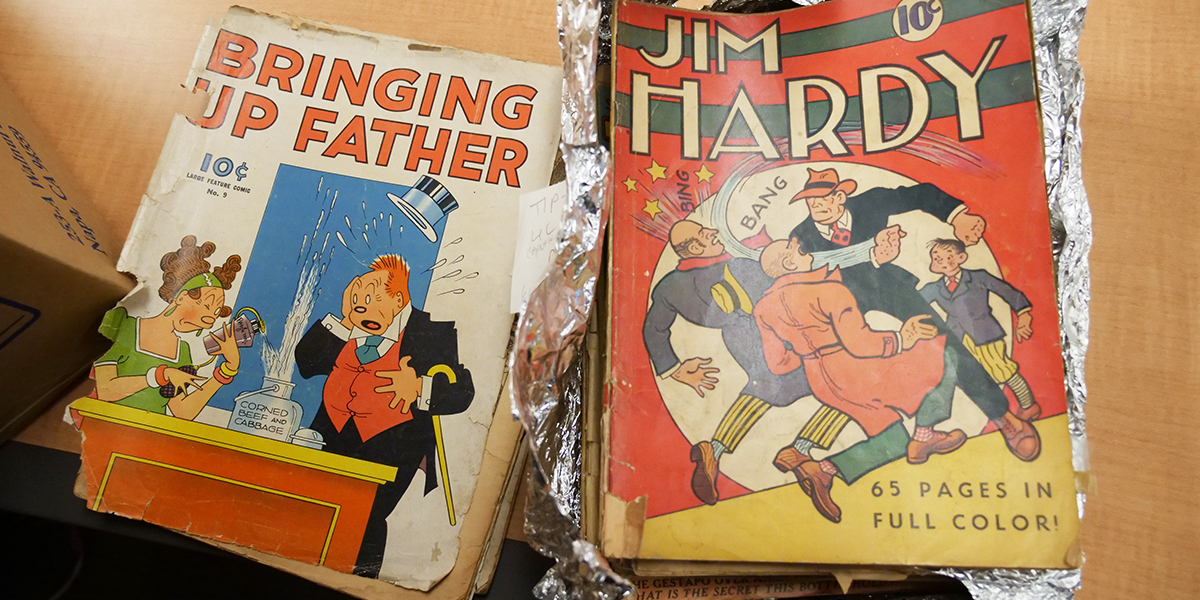
It’s a bird. It’s a plane. It’s … an original copy of Superman No. 1. The comic book is among 963 original, rare classics from the genre’s platinum and golden eras recently donated to San Francisco State.
Beginning this fall, students will be able to go up, up and away to the J. Paul Leonard Library to research this unique part of American art and culture. The Thomas Bentley Rue Collection of Golden and Silver Age Comic Art will serve as a valuable resource for the School of Humanities and Liberal Studies’ newly established Comics Studies program.
Rue’s estate donated the collection, valued at $45,000, to the University. In addition, Rue’s wife, Virginia, made a $5,000 donation to assist the library in purchasing necessary supplies to catalog and house the collection.
“The real materials — with staples, ads, all the things that someone handled 70 years ago — can now be picked up by our students and scholars,” says Assistant Professor Nick Sousanis, Comics Studies coordinator. “We see reprints of the more popular stories from the time, but they never include all the other materials that are lost to history. And here we’ll have that.”
Besides the original Superman, other highlights of the collection include the No. 2 issue of Plastic Man, 109 copies of Walt Disney’s Comics and Stories, 127 Dell Comics in Four Color, 42 Looney Toons and Merrie Melodies and a handful of Captain Marvel Adventures. They span the 1930s and 1940s with a few from the early 1950s. Most are in good condition.
It’s not all superheroes and anthropomorphic animals though, Sousanis notes. “[The collection] expands our early picture of what comics offered in positive ways,” he says. “There are also books like Disney’s Song of the South comic in there that are useful, if difficult, to explore prejudiced depictions of race.”
A lifelong love of comics
The comics are from the childhood collection of Thomas and Loring Rue, brothers who grew up in Norfolk, Virginia, between the 1930s and 1950s. Their mother would often buy them comics at a local drug store on her way home from work. She would read them aloud to a preschool-aged Tommy, engendering a lifelong love of books. Throughout his career in the military and as a teacher, he never lost his interest in comic art, says Virginia Rue, Thomas’s widow.
Thomas Rue treasured his comics: the artwork, the characters, the way they reflected society. Little Orphan Annie persevered through the Great Depression. Dick Tracy fought organized crime. Military Comics and War Heroes made him aspire to become a soldier. Disney, especially Mickey Mouse, warmed his heart.
“He believed that his much-loved collection represented a snapshot of our history — socially, culturally and politically,” adds Virginia Rue, a retired schools superintendent who earned an administration credential from San Francisco State in 1976.
In the early 1970s, Thomas moved the collection from his mother’s attic in Norfolk to his new home in Napa and stored them securely. Decades later, he augmented the collection with 300 books of adventure strips. By then he had decided that he wanted to donate everything to a university library. He was actively seeking a permanent home for the collection when he died in November 2016 at age 79.
As an adult, Thomas’ comics had helped him to reflect on his own childhood during the 1930s and 1940s. Now, students and others can use his collection to learn more about the origins of the comic art form and that period of American history.
“We get a sense of what two boys of this time were reading, what shaped their interests,” Sousanis says. “This moves it beyond comics and gives us a window into the times.”
— Matt Itelson
Links
- Minor in Comics Studies
- News article: Humanities Professor Nick Sousanis Takes Home Eisner Award, August 3, 2018
- News article: Award-winning Graphic Novelist Nick Sousanis Teaches New Comics Courses, January 24, 2017
Photo by Gail Mallimson